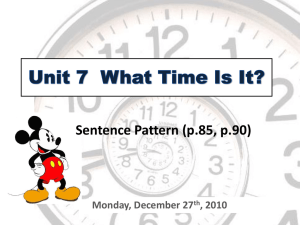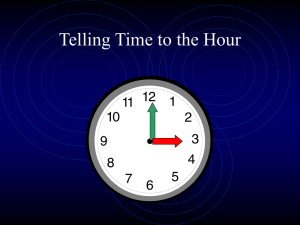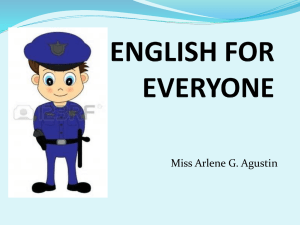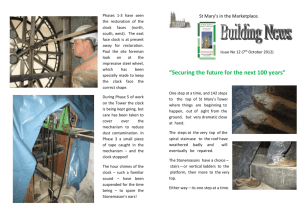Autumn TS M2 - Hamilton Trust
advertisement
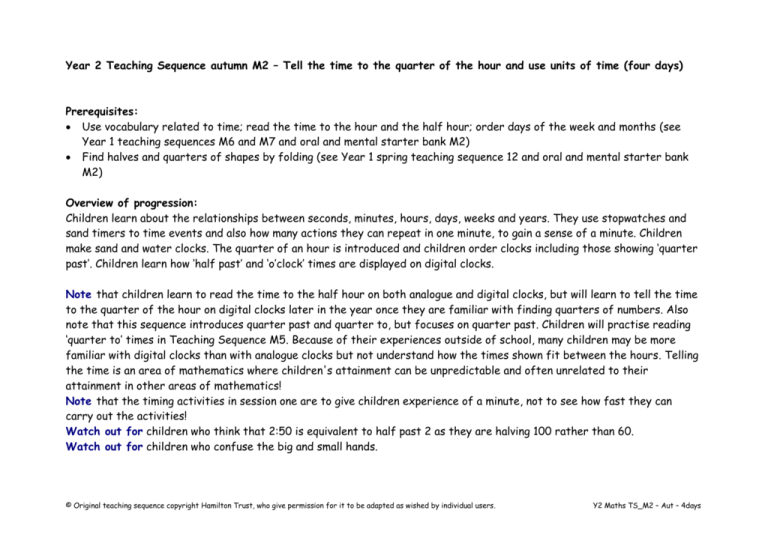
Year 2 Teaching Sequence autumn M2 – Tell the time to the quarter of the hour and use units of time (four days) Prerequisites: Use vocabulary related to time; read the time to the hour and the half hour; order days of the week and months (see Year 1 teaching sequences M6 and M7 and oral and mental starter bank M2) Find halves and quarters of shapes by folding (see Year 1 spring teaching sequence 12 and oral and mental starter bank M2) Overview of progression: Children learn about the relationships between seconds, minutes, hours, days, weeks and years. They use stopwatches and sand timers to time events and also how many actions they can repeat in one minute, to gain a sense of a minute. Children make sand and water clocks. The quarter of an hour is introduced and children order clocks including those showing ‘quarter past’. Children learn how ‘half past’ and ‘o’clock’ times are displayed on digital clocks. Note that children learn to read the time to the half hour on both analogue and digital clocks, but will learn to tell the time to the quarter of the hour on digital clocks later in the year once they are familiar with finding quarters of numbers. Also note that this sequence introduces quarter past and quarter to, but focuses on quarter past. Children will practise reading ‘quarter to’ times in Teaching Sequence M5. Because of their experiences outside of school, many children may be more familiar with digital clocks than with analogue clocks but not understand how the times shown fit between the hours. Telling the time is an area of mathematics where children's attainment can be unpredictable and often unrelated to their attainment in other areas of mathematics! Note that the timing activities in session one are to give children experience of a minute, not to see how fast they can carry out the activities! Watch out for children who think that 2:50 is equivalent to half past 2 as they are halving 100 rather than 60. Watch out for children who confuse the big and small hands. © Original teaching sequence copyright Hamilton Trust, who give permission for it to be adapted as wished by individual users. Y2 Maths TS_M2 – Aut – 4days Objectives: Use units of time (seconds, minutes, hours, days and weeks) and know the relationships between them Read the time to the quarter of an hour on digital and analogue clocks Begin to identify time intervals, including those that cross the hour Whole class Group activities Paired/indiv practice Resources Show a clock with a second hand to the children. This clock has a minute hand and an hour hand but it also has a second hand. We can see it moving. Let’s count the seconds. Wait until the second hand is at the top and count together each time it moves, stopping when it reaches the top again. We counted 60 because there are 60 seconds in a minute, so this hand takes 60 seconds to go around the clock, whilst the minute hand moves forward just one minute. There are 60 minutes in one hour, and so the minute hand moves 60 times in the time that it takes the hour hand to move from one number to the next. How many times do you think you could write your name in one minute? Take some suggestions and discuss how some names will take longer to write than others and so some children will write their name fewer times. Then use the second hand on the clock to time one minute as children write their names on their whiteboards. Give each child a stopwatch (or as many children as possible) and explain how to stop and start it. Start your watches and stop them after 20 seconds. What do you think you could do in 20 seconds? Try a few suggestions. How long do you think it will take us to count round the class? Use the stopwatches to time this. Group of 4-5 children Show children a range of sand timers. The sand in each of these sand timers takes a particular time to go through from the top to the bottom. Some people use these to time boiling an egg. One of these timers times half a minute, one times one minute, one two minutes and one three minutes. (Adjust according to the timers you have.) Which do you think is which and why? Write children’s suggestions on Post-its™ and stick them to the timers. Tip them upside down at the same time and start a stopwatch, calling out the times when each has emptied its sand into the lower half. We’re going to make our own sand timer. We have two plastic bottles and a piece of card. Place the card under one of the bottle necks and draw around it. Poke a hole through the middle. Place about two cups of sand (perhaps mixed with a little glitter!) in one of the bottles. Place the card over the bottle, so that the outline aligns with its neck, place the other bottle over the other so that the two necks align, and very carefully tip/turn the bottles through 180° over a cardboard box/tray to catch any spillages. Ask a child to start the stopwatch at the same time. They should shout Children take in turn to use a stop watch to time how long it takes their partner to: Write their first name five times; Make a tower of ten cubes; Count to 30; Stand up and sit down 5 times; Write numbers 1 to 20 in order. They record their results in a table (see resources). Harder: Children first predict which will take the longest and the shortest. Stopwatches A range of sand timers Two identical transparent plastic bottles, card, scissors, sand, funnel, cardboard box/tray and tape Table to records results (see resources) © Original teaching sequence copyright Hamilton Trust, who give permission for it to be adapted as wished by individual users. Y2 Maths TS_M2 – Aut – 4days Show children a geared analogue clock. Each of these little marks around the outside of the clock shows one minute, so the minute hand shows us one minute has passed when it moves from one little mark to the next. They are in groups of five. Let’s count the number of minutes in one hour. Move the minute hand and count on in 5s: five, ten, fifteen, twenty… sixty. There are sixty minutes in one hour. Look what’s happened to the hour hand. It’s moved forward by one hour. How many minutes do you think there might be in half an hour? Count round in fives to check. How many hours are there in a day? The hour hand moves round the whole clock twice in a day, that’s why we have the same time twice each day, so 8 o’clock can be 8 o’clock in the morning or 8 o’clock in the evening. How many days are there in a week? How many are usually school days? And how many are at the weekend? And there are 52 weeks in one year! stop when one minute is up. Has all of the sand gone through? Did it go through too quickly? How can we change it? Discuss making the hole bigger/smaller and using more/less sand. Repeat until the sand passes through in approximately one minute. Remove the card, cut round the neck outline, replace and use tape to seal the two bottles together. Harder: Give a timer to each pair of children to time. They might be able to work in pairs to make their own sand timers. Group of 4-5 children Work together to make a water clock. Give a stop watch to each child. Cut a clear plastic litre bottle in half, make a small hole in the lid, place the top half of the bottle upside down, in the bottom half of the bottle, and pour two cups of water into the top half and ask the first child to start their stop watch. They should call out after one minute, you mark on the level of water with a pen, as the next child starts their stopwatch. Continue until all children have timed a minute. Where do you think the water will be after 10 minutes? Mark on some approximations. Easier: Instead of using stopwatches, children use sand timers. © Original teaching sequence copyright Hamilton Trust, who give permission for it to be adapted as wished by individual users. Children shuffle cards of equivalent times. They turn over a sand timer and see if they can find all the pairs of equivalent times before the timer runs out. They then use the cards to play pelmanaism. (They shuffle cards and turn them face down, and then take it in turns to turn two over and see if they are different ways of saying the same lengths of time e.g. 60 seconds and one minute. If they are the same, they keep them, if not they turn them over again. The winner is the person with the most cards.) Easier: Children could use one minute sand timers. Harder: Cards include extra pairs, e.g. 30 minutes and half an hour (see resources). Geared analogue clock Clear plastic litre bottle with lid Scissors, sharp point such as a pair of compasses, CD/OHP marker Sand timers (preferably 30 seconds) Equivalent times cards (see resources) Y2 Maths TS_M2 – Aut – 4days Launch the ITP Tell Time. Stop the clock and use the toggle to change it to 9 o’clock. Display both the analogue and digital clocks. Both these clocks show 9 o’clock. This one is a digital clock, where have you seen clocks like this? The digital clock has a zero before the 9, some clocks show this and some don’t. It fills the space when it’s not 10, 11 or 12 o’clock, but we don’t need to write it. Group of 4-5 children Play Time Bingo to give children extra practice in recognising equivalent times (see resources for game boards). Give a different game board to each child. Cut up a copy of the cards for questions and shuffle them. Use them to ask questions such as the following: If you have a clock, which shows 3 o’clock, put a counter on it; If you have a clock which shows half past 7 put a counter on it; A child wins when they have covered all their clocks. Repeat, asking children to swap game boards, and shuffling the pack of times used for questions. Easier: Give game boards to pairs of children so that they can support each other. Children practise reading equivalent times (o’clock and half past) on analogue and digital clocks (see resources) and then put times in order. Harder: There are more blank equivalent times to complete and the times are not consecutive half hours. ITP Tell Time Time bingo game boards and cut out copies of question cards (see resources) Counters Activity sheet of analogue and digital clock faces (see resources) Glue sticks and scissors Choose an interval of half of an hour and click. The minute hand has moved half way round the clock and the hour hand has moved to half way between 9 and 10. What’s happened to the digital clock? Why? Let’s see the time half an hour later. Click the half toggle again. What time is it now? Repeat several times. Then click to hide the digital clock, advance the time by half an hour and ask children to write the digital time on their whiteboards. Repeat several times. © Original teaching sequence copyright Hamilton Trust, who give permission for it to be adapted as wished by individual users. Y2 Maths TS_M2 – Aut – 4days Give each child a circle of paper. Fold your circle in half. Now fold it in half again so that you have four equal parts. (Demonstrate folding into quarters if necessary.) What do we call these parts? This circle is a bit like a clock face. Write 12 at the top. What number goes at the bottom? Why? Draw out that 6 is half of 12, 6 is half way round the clock. Point to where 3 should go on the clock face. What number can we write here? This number is a quarter of the way round the clock face. When the minute hand is here, it is a quarter of an hour past an hour. Point to where the 9 should go. And here? When the minute hand is here, it has a quarter of an hour to go until the next o’clock time. Launch the ITP Tell Time, just display the analogue clock, show 9 o’clock and a time interval of quarter of an hour. What time does the clock show now? Click on ¼ hour. Now it shows a quarter past 9, this means it’s a quarter of an hour after 9 o’clock. We write it like this. Write ‘quarter past 9’ and ‘¼ past 9’ on the board. Click ¼ hour again. What time is it now? Click again. Now it’s only quarter of an hour before it’s 10 o’clock, look how the hour hand is now quite close to 10 o’clock. We call this time quarter to 10. Click ¼ hour again. It’s quarter of an hour later, so it’s now 10 o’clock. Press ¼ hour again. What time is it now? Change the time interval to one hour and click repeatedly asking children to write the time on their whiteboards. Point out how they just need to rub out the last number each time. Group of 4-5 children Show 3 o’clock on a geared analogue clock. Show me the time on your clocks that is quarter of an hour later than this. How do we say that time? Move the minute hand to a quarter round the clock to show children quarter past 3 and discuss what happens to the hour hand. Now show me the time that is quarter of an hour later than quarter past 3. What time is that? Ask questions involving simple time intervals, asking children to respond by showing you their clocks such as the following: Show 12 o’clock on your clock. A class go in for lunch at this time. They take quarter of an hour to eat their lunch and then go out to the playground. What time do they go out into the playground? Show me. A TV programme starts at 5 o’clock. It lasts half an hour. What time does it finish? Show me. Sam goes to bed at 8 o’clock. It’s half past 7 now. How long is it before he goes to bed? Show me quarter past nine on your clocks. If assembly starts at quarter past nine and lasts for quarter of an hour, what time does it finish? Show quarter past 3 on the clock. This is the time that we finish school. If we have PE in the afternoon, we need ¼ of an hour to get changed, give out letters and book bags and get our coats. What time should we come back to the classroom? Show me. © Original teaching sequence copyright Hamilton Trust, who give permission for it to be adapted as wished by individual users. Children work in pairs to cut out times and stick them in order (see resources). Harder: Children have to write times underneath each clock first. Paper circles ITP Tell Time Geared analogue clock Small clocks for children to use Activity sheets of times to order (see resources) Glue sticks and scissors Y2 Maths TS_M2 – Aut – 4days Easier: Focus more on half hour intervals to begin with. Harder: If children are confident, include some times involving quarter to the hour. © Original teaching sequence copyright Hamilton Trust, who give permission for it to be adapted as wished by individual users. Y2 Maths TS_M2 – Aut – 4days



